Dynamic Leadership
VerifiedAdded on 2022/11/28
|5
|857
|156
AI Summary
This assignment discusses the concept of self-development in the role of a leader in business organizations, focusing on strengths and limitations. It reflects on the thoughts, ideas, and experiences of the author, describing their journey of leadership and the application of determining strengths and limitations.
Contribute Materials
Your contribution can guide someone’s learning journey. Share your
documents today.
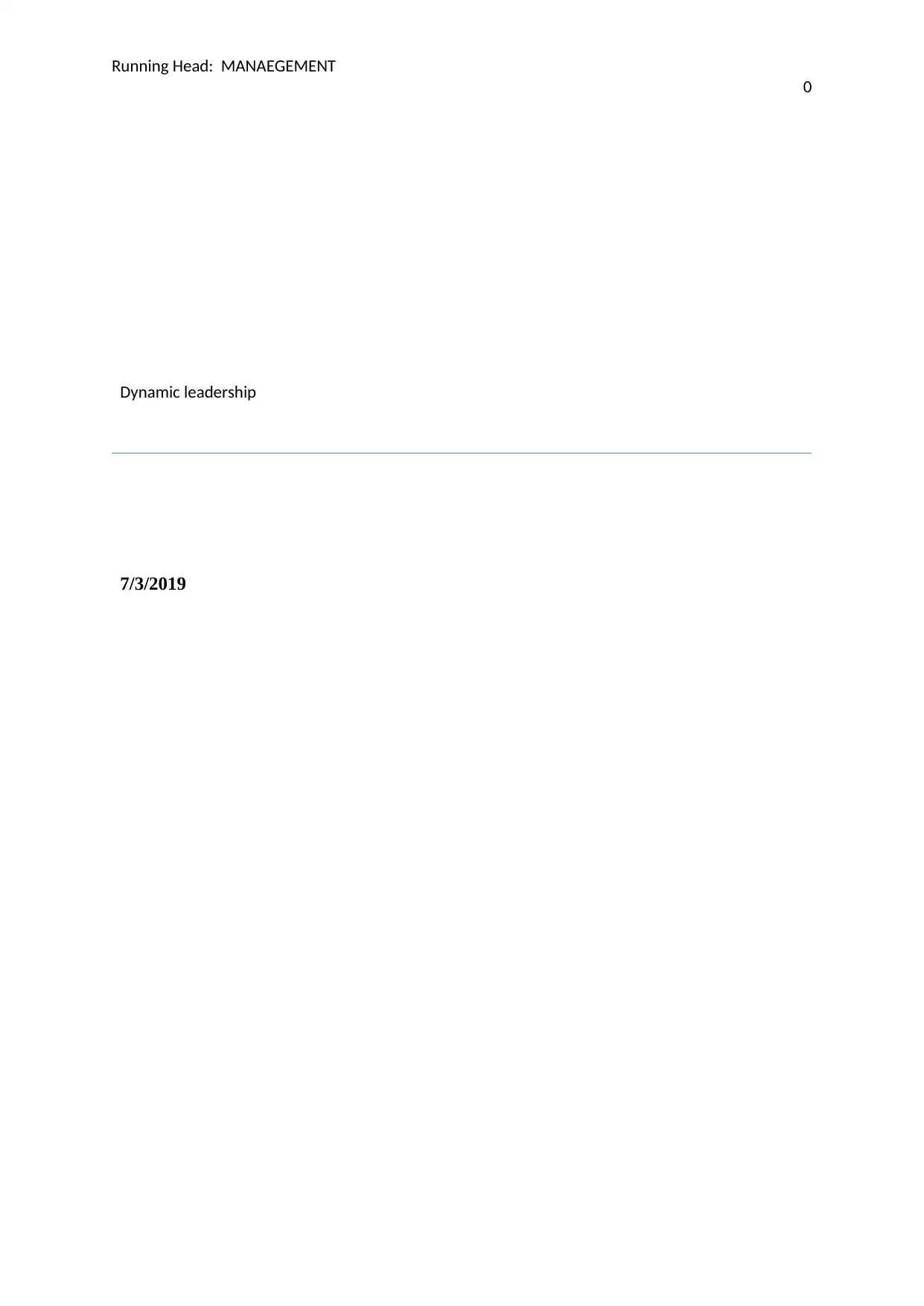
Running Head: MANAEGEMENT
0
Dynamic leadership
7/3/2019
0
Dynamic leadership
7/3/2019
Secure Best Marks with AI Grader
Need help grading? Try our AI Grader for instant feedback on your assignments.
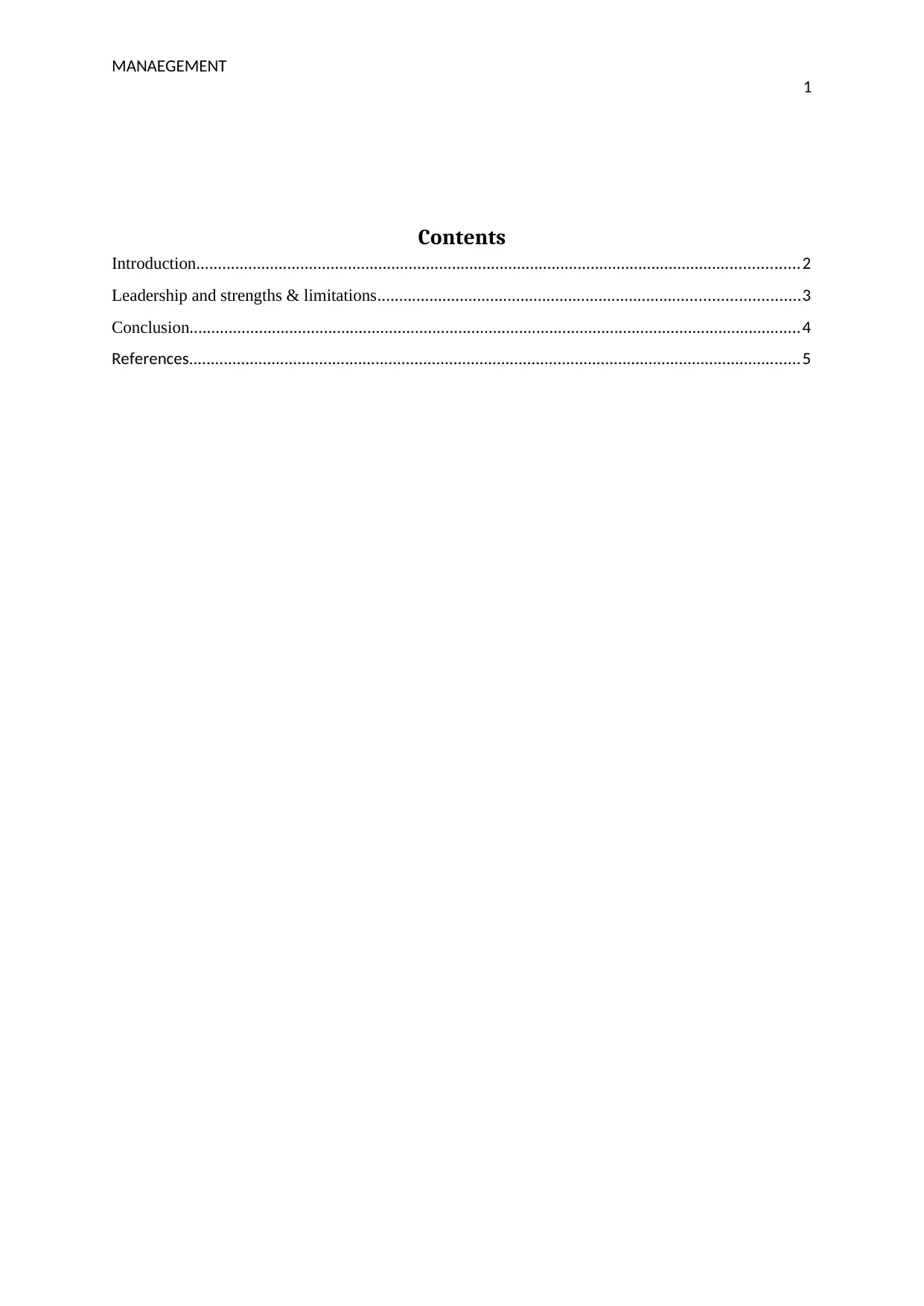
MANAEGEMENT
1
Contents
Introduction...........................................................................................................................................2
Leadership and strengths & limitations.................................................................................................3
Conclusion.............................................................................................................................................4
References.............................................................................................................................................5
1
Contents
Introduction...........................................................................................................................................2
Leadership and strengths & limitations.................................................................................................3
Conclusion.............................................................................................................................................4
References.............................................................................................................................................5
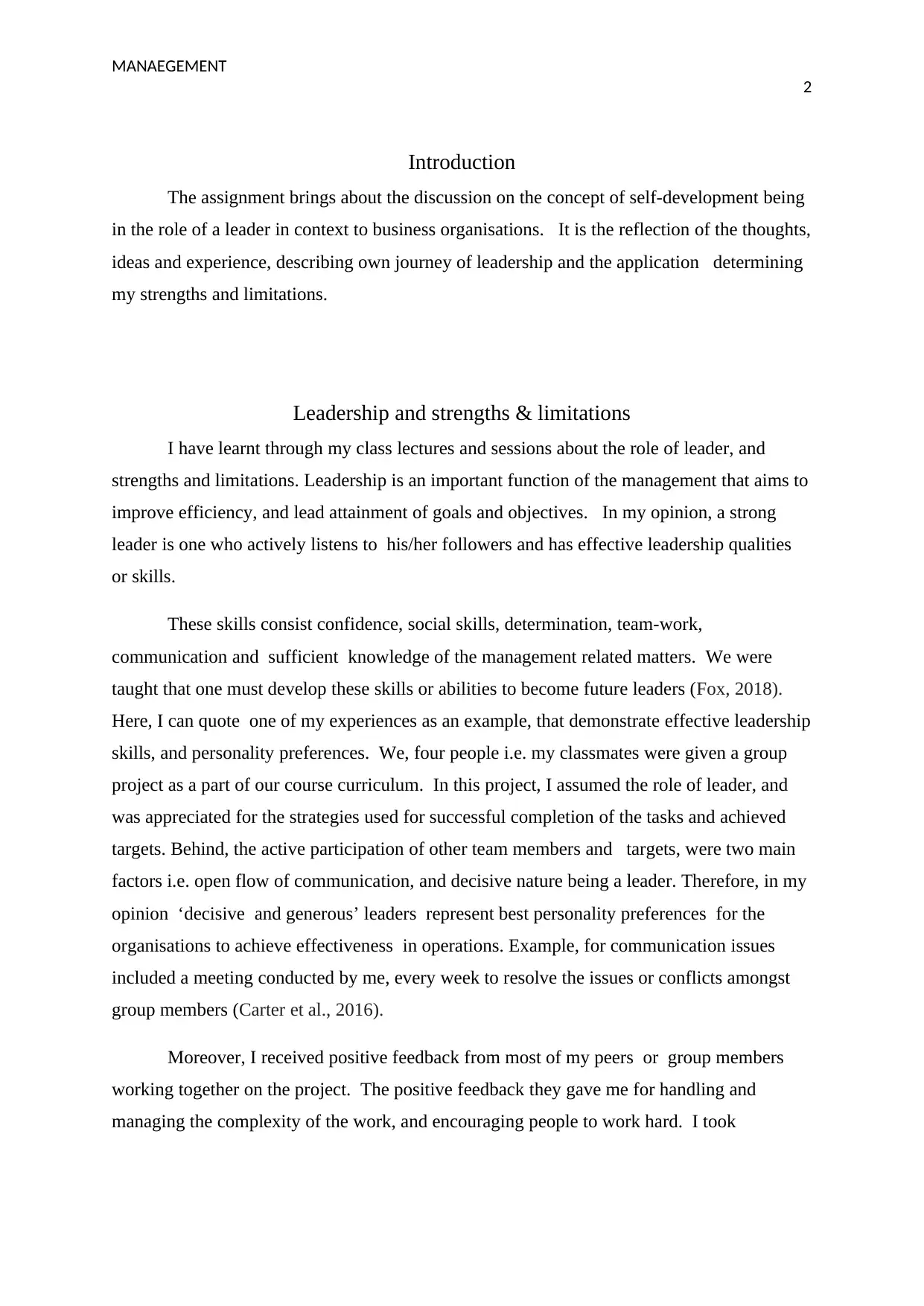
MANAEGEMENT
2
Introduction
The assignment brings about the discussion on the concept of self-development being
in the role of a leader in context to business organisations. It is the reflection of the thoughts,
ideas and experience, describing own journey of leadership and the application determining
my strengths and limitations.
Leadership and strengths & limitations
I have learnt through my class lectures and sessions about the role of leader, and
strengths and limitations. Leadership is an important function of the management that aims to
improve efficiency, and lead attainment of goals and objectives. In my opinion, a strong
leader is one who actively listens to his/her followers and has effective leadership qualities
or skills.
These skills consist confidence, social skills, determination, team-work,
communication and sufficient knowledge of the management related matters. We were
taught that one must develop these skills or abilities to become future leaders (Fox, 2018).
Here, I can quote one of my experiences as an example, that demonstrate effective leadership
skills, and personality preferences. We, four people i.e. my classmates were given a group
project as a part of our course curriculum. In this project, I assumed the role of leader, and
was appreciated for the strategies used for successful completion of the tasks and achieved
targets. Behind, the active participation of other team members and targets, were two main
factors i.e. open flow of communication, and decisive nature being a leader. Therefore, in my
opinion ‘decisive and generous’ leaders represent best personality preferences for the
organisations to achieve effectiveness in operations. Example, for communication issues
included a meeting conducted by me, every week to resolve the issues or conflicts amongst
group members (Carter et al., 2016).
Moreover, I received positive feedback from most of my peers or group members
working together on the project. The positive feedback they gave me for handling and
managing the complexity of the work, and encouraging people to work hard. I took
2
Introduction
The assignment brings about the discussion on the concept of self-development being
in the role of a leader in context to business organisations. It is the reflection of the thoughts,
ideas and experience, describing own journey of leadership and the application determining
my strengths and limitations.
Leadership and strengths & limitations
I have learnt through my class lectures and sessions about the role of leader, and
strengths and limitations. Leadership is an important function of the management that aims to
improve efficiency, and lead attainment of goals and objectives. In my opinion, a strong
leader is one who actively listens to his/her followers and has effective leadership qualities
or skills.
These skills consist confidence, social skills, determination, team-work,
communication and sufficient knowledge of the management related matters. We were
taught that one must develop these skills or abilities to become future leaders (Fox, 2018).
Here, I can quote one of my experiences as an example, that demonstrate effective leadership
skills, and personality preferences. We, four people i.e. my classmates were given a group
project as a part of our course curriculum. In this project, I assumed the role of leader, and
was appreciated for the strategies used for successful completion of the tasks and achieved
targets. Behind, the active participation of other team members and targets, were two main
factors i.e. open flow of communication, and decisive nature being a leader. Therefore, in my
opinion ‘decisive and generous’ leaders represent best personality preferences for the
organisations to achieve effectiveness in operations. Example, for communication issues
included a meeting conducted by me, every week to resolve the issues or conflicts amongst
group members (Carter et al., 2016).
Moreover, I received positive feedback from most of my peers or group members
working together on the project. The positive feedback they gave me for handling and
managing the complexity of the work, and encouraging people to work hard. I took
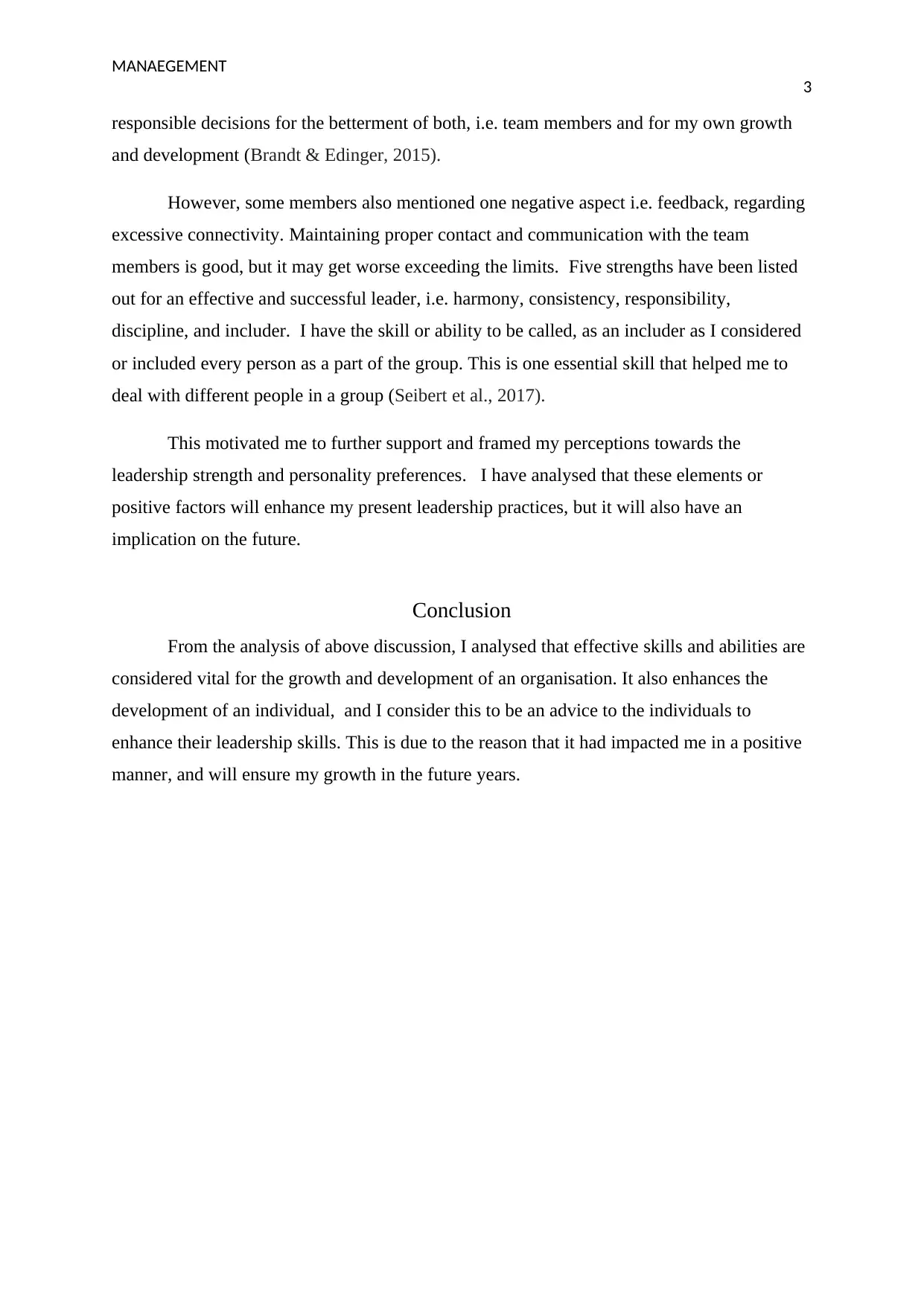
MANAEGEMENT
3
responsible decisions for the betterment of both, i.e. team members and for my own growth
and development (Brandt & Edinger, 2015).
However, some members also mentioned one negative aspect i.e. feedback, regarding
excessive connectivity. Maintaining proper contact and communication with the team
members is good, but it may get worse exceeding the limits. Five strengths have been listed
out for an effective and successful leader, i.e. harmony, consistency, responsibility,
discipline, and includer. I have the skill or ability to be called, as an includer as I considered
or included every person as a part of the group. This is one essential skill that helped me to
deal with different people in a group (Seibert et al., 2017).
This motivated me to further support and framed my perceptions towards the
leadership strength and personality preferences. I have analysed that these elements or
positive factors will enhance my present leadership practices, but it will also have an
implication on the future.
Conclusion
From the analysis of above discussion, I analysed that effective skills and abilities are
considered vital for the growth and development of an organisation. It also enhances the
development of an individual, and I consider this to be an advice to the individuals to
enhance their leadership skills. This is due to the reason that it had impacted me in a positive
manner, and will ensure my growth in the future years.
3
responsible decisions for the betterment of both, i.e. team members and for my own growth
and development (Brandt & Edinger, 2015).
However, some members also mentioned one negative aspect i.e. feedback, regarding
excessive connectivity. Maintaining proper contact and communication with the team
members is good, but it may get worse exceeding the limits. Five strengths have been listed
out for an effective and successful leader, i.e. harmony, consistency, responsibility,
discipline, and includer. I have the skill or ability to be called, as an includer as I considered
or included every person as a part of the group. This is one essential skill that helped me to
deal with different people in a group (Seibert et al., 2017).
This motivated me to further support and framed my perceptions towards the
leadership strength and personality preferences. I have analysed that these elements or
positive factors will enhance my present leadership practices, but it will also have an
implication on the future.
Conclusion
From the analysis of above discussion, I analysed that effective skills and abilities are
considered vital for the growth and development of an organisation. It also enhances the
development of an individual, and I consider this to be an advice to the individuals to
enhance their leadership skills. This is due to the reason that it had impacted me in a positive
manner, and will ensure my growth in the future years.
Secure Best Marks with AI Grader
Need help grading? Try our AI Grader for instant feedback on your assignments.
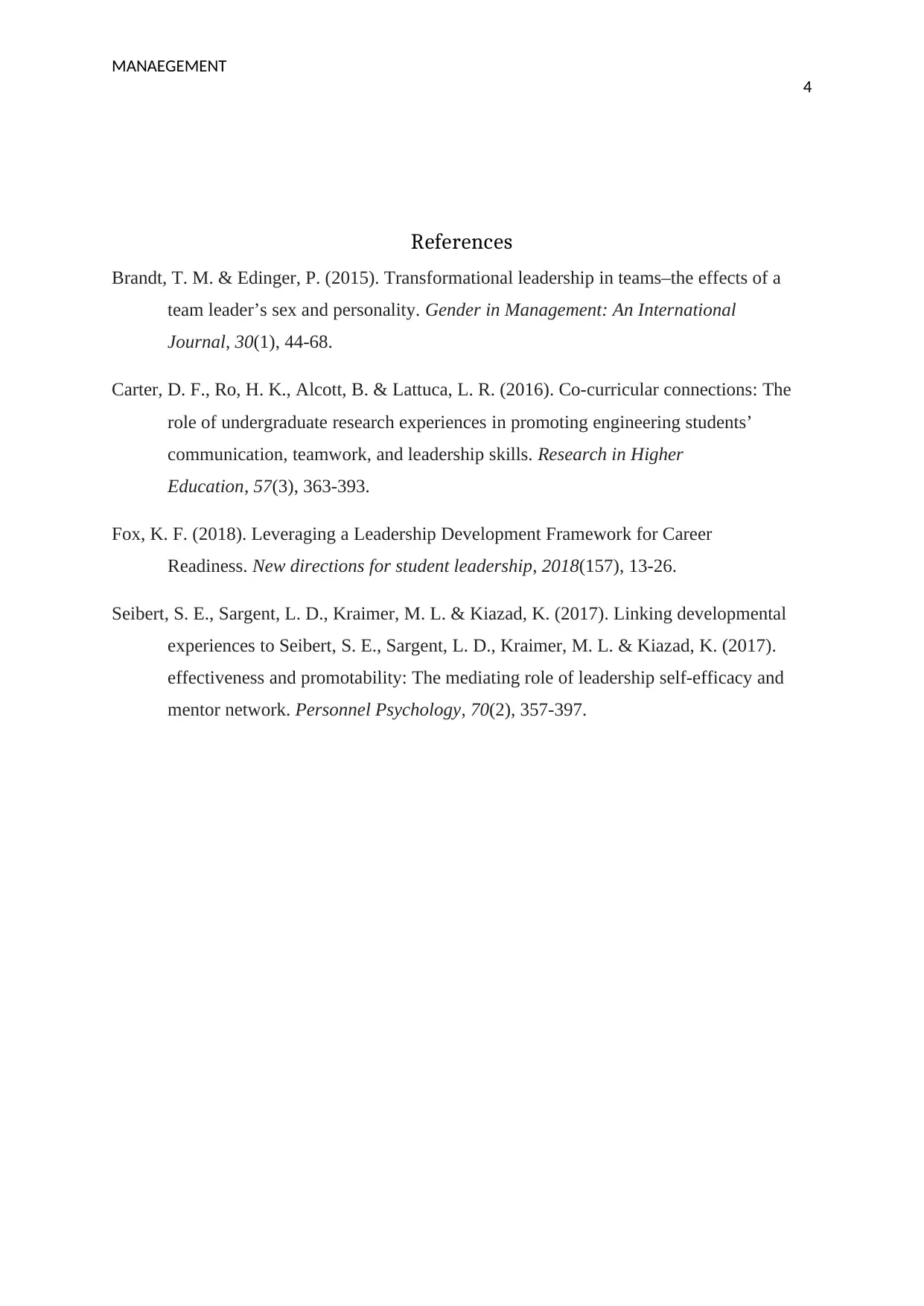
MANAEGEMENT
4
References
Brandt, T. M. & Edinger, P. (2015). Transformational leadership in teams–the effects of a
team leader’s sex and personality. Gender in Management: An International
Journal, 30(1), 44-68.
Carter, D. F., Ro, H. K., Alcott, B. & Lattuca, L. R. (2016). Co-curricular connections: The
role of undergraduate research experiences in promoting engineering students’
communication, teamwork, and leadership skills. Research in Higher
Education, 57(3), 363-393.
Fox, K. F. (2018). Leveraging a Leadership Development Framework for Career
Readiness. New directions for student leadership, 2018(157), 13-26.
Seibert, S. E., Sargent, L. D., Kraimer, M. L. & Kiazad, K. (2017). Linking developmental
experiences to Seibert, S. E., Sargent, L. D., Kraimer, M. L. & Kiazad, K. (2017).
effectiveness and promotability: The mediating role of leadership self‐efficacy and
mentor network. Personnel Psychology, 70(2), 357-397.
4
References
Brandt, T. M. & Edinger, P. (2015). Transformational leadership in teams–the effects of a
team leader’s sex and personality. Gender in Management: An International
Journal, 30(1), 44-68.
Carter, D. F., Ro, H. K., Alcott, B. & Lattuca, L. R. (2016). Co-curricular connections: The
role of undergraduate research experiences in promoting engineering students’
communication, teamwork, and leadership skills. Research in Higher
Education, 57(3), 363-393.
Fox, K. F. (2018). Leveraging a Leadership Development Framework for Career
Readiness. New directions for student leadership, 2018(157), 13-26.
Seibert, S. E., Sargent, L. D., Kraimer, M. L. & Kiazad, K. (2017). Linking developmental
experiences to Seibert, S. E., Sargent, L. D., Kraimer, M. L. & Kiazad, K. (2017).
effectiveness and promotability: The mediating role of leadership self‐efficacy and
mentor network. Personnel Psychology, 70(2), 357-397.
1 out of 5
Related Documents
Your All-in-One AI-Powered Toolkit for Academic Success.
+13062052269
info@desklib.com
Available 24*7 on WhatsApp / Email
![[object Object]](/_next/static/media/star-bottom.7253800d.svg)
Unlock your academic potential
© 2024 | Zucol Services PVT LTD | All rights reserved.





